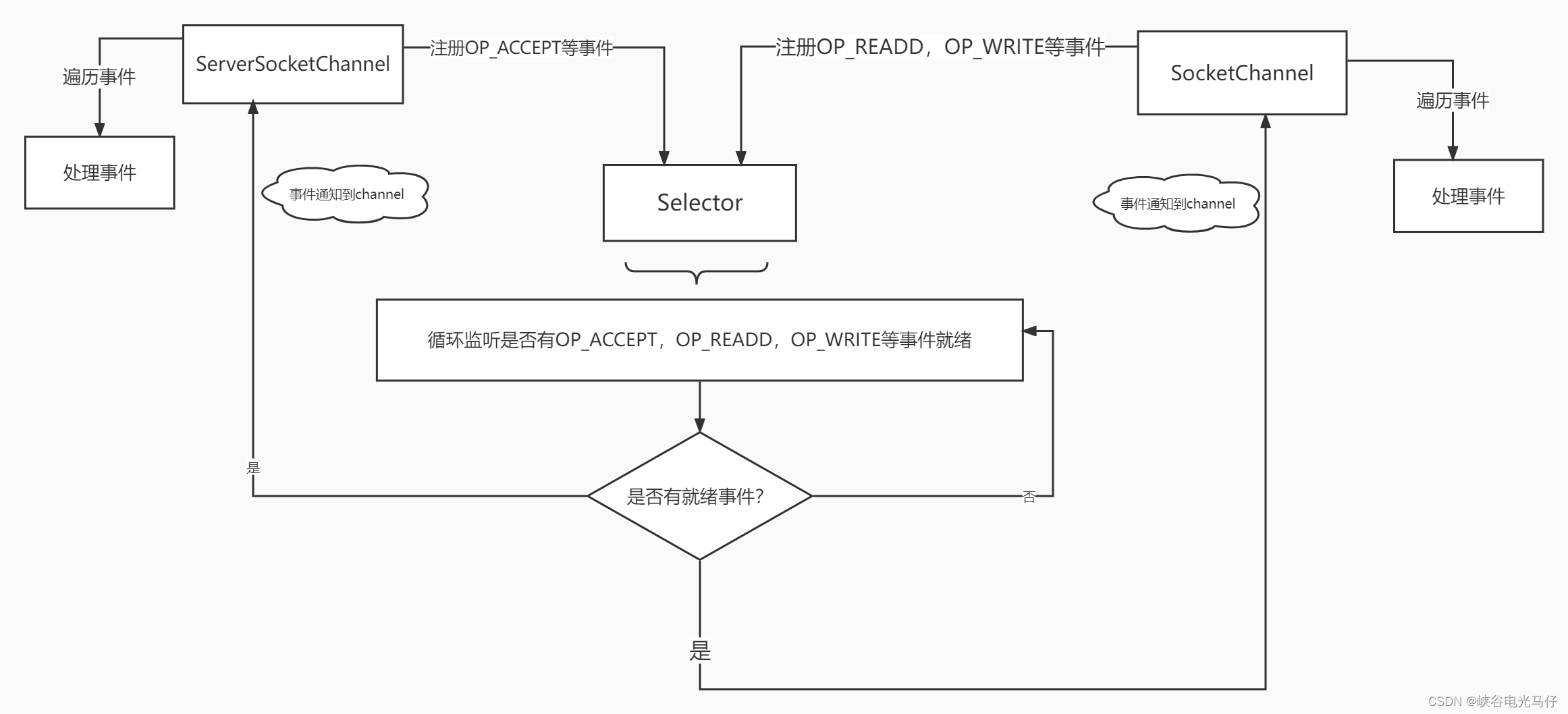BIO 介绍与原理
BIO 全程Blocking I/O ,阻塞io, 是java最早的 网络io模型 基于基本ServerSocket ,Socket 实现, SOCKET 所有的操作都是基于阻塞IO的,比如socket inpustream read方法 如果没有数据进来就会一直阻塞,除非新创建线程处理每一个socket
BIO 匹配我们饭店吃饭场景
我们先到第一个窗口,发现厨师还没做好,那么就一直等着,直到这到菜做好了,我们拿到这个菜,然会回到座位吃完了
然后又去第二个窗口,等待第二道菜做好,然后拿回座位吃完,以此循环下去
以上场景可以匹配ServerSocket 的accept 方法,以及Socket 的read write方法
一般解决方案是每一个socket 启用一个thread 处理,这会导致并发数很低
BIO 优缺点:
优点:代码通俗易懂,在低并发场景或者分布式场景依然应用很广 缺点: 所有流程都是阻塞模式,需要依赖创建多个thread 处理每个socket,并发量很低
BIO运行图:

BIO 案例代码:
服务端最简单示例:
创建服务端有客户端连接后发送hello 字符串,并接受客户端reply 回复
/**
* @description: demos of jdk8 java.net.ServerSocket class
* 创建服务端,有客户端连接后发送hello 字符串,并接受客户端reply 回复
*
* */
@Test
public void testServer() throws IOException {
ServerSocket serverSocket = new ServerSocket(8679);
while(true){
Socket socket = serverSocket.accept();
socket.getOutputStream().write("hello".getBytes());
try{
ByteBuffer byteBuffer = ByteBuffer.allocate(1024);
byte[] bytes = new byte[1024];
int read = 0;
while ((read =socket.getInputStream().read(bytes))>0){
byteBuffer.put(bytes,0,read);
byteBuffer.flip();
String rs = new String(byteBuffer.array());
System.out.println(rs);
byteBuffer.clear();
}
}catch (Exception e){
e.printStackTrace();
}finally {
if(!socket.isClosed()) {
try {
socket.close();
}catch (Exception e1){
e1.printStackTrace();
}
}
}
}
}
客户端最简单示例: 创建客户端,连接到服务端后接收到hello 字符串,并接向服务端发送reply 字符串回复
/**
* @description: demos of jdk8 java.net.Socket class
* 创建客户端,连接到服务端后接收到hello 字符串,并接向服务端发送reply 字符串回复
*/
@Test
public void testClient() throws IOException {
Socket socket = new Socket("127.0.0.1", 8679);
ByteBuffer byteBuffer = ByteBuffer.allocate(1024);
byte[] bytes = new byte[1024];
int read = 0;
while ((read = socket.getInputStream().read(bytes)) > 0) {
byteBuffer.put(bytes, 0, read);
byteBuffer.flip();
String rs = new String(byteBuffer.array());
byteBuffer.clear();
System.out.println(rs);
socket.getOutputStream().write("reply".getBytes());
}
}
NIO 介绍与原理
NIO 全称 non-blocking I/O ,意思是非阻塞io 与上面BIO 对应的,是JAVA 后加入的nio 包内的网络io模型 核心类是Selector , ServerSocketChannel,SocketChannel
NIO 匹配我们饭店吃饭场景
同样是进了一个饭店,饭店有几个窗口,每个窗口做不同的菜,比如宫保鸡丁,油闷大虾,醋溜鱼等等
我们这次选择另一种方式等菜,我们不断的在每个窗口走来走去,而不是一直等在某个窗口
每一轮查看就把所有做好的菜一起打包带走,拿回来放到桌上吃完,然后在去窗口再继续一轮轮循环往复
这样做对程序来说的好处就是一直只有一个线程在不断循环监听某些事件就绪了也就是Selector的select()方法,相当于上面的查看哪些菜好了
NIO 优缺点:
优点:这样做极大的压缩了需要使用的线程,极大的提高了并发量 确定:在高并发场景下会有阻塞问题,因为在处理某个任务的时候其他事件的处理需要等待
NIO运行图:

NIO 案例代码:
NIO 服务端最简单示例:
创建服务端,有客户端连接后发送hello 字符串,并接受客户端reply 回复
/**
* @description: demos of jdk8 java.nio.ServerSocketChannel class
* java.nio.ServerSocketChannel 作用:ServerSocketChannel 是 socket nio server 服务端
* ServerSocketChannel 例子:
* nio 服务端简单demo,流程如下
* 1. 服务端创建并注册OP_ACCEPT事件到selector 中
* 2. 循环获取selector中事件
* 2.1 如果是OP_ACCEPT 事件,则获取到对应连接的客户端socketChannel
* 2.2 将socketChannel 注册读事件OP_READ到selector 中
* 2.3 如果是OP_READ ,则读取信息
*/
@Test
public void testServerSocketChannel() throws IOException {
Selector selector = Selector.open();
ServerSocketChannel ssc = ServerSocketChannel.open();
ssc.bind(new InetSocketAddress(8970));
ssc.configureBlocking(false);
ssc.register(selector, SelectionKey.OP_ACCEPT);
ByteBuffer byteBuffer = ByteBuffer.allocate(1024);
while (true) {
selector.select();
Iterator<SelectionKey> skIterator = selector.selectedKeys().iterator();
while (skIterator.hasNext()) {
SelectionKey sk = skIterator.next();
try {
if (sk.isValid() && sk.isAcceptable()) {
ServerSocketChannel assc = (ServerSocketChannel) sk.channel();
SocketChannel asc = assc.accept();
asc.configureBlocking(false);
asc.register(selector, SelectionKey.OP_READ);
byteBuffer.clear();
byteBuffer.put("hello".getBytes());
byteBuffer.flip();
asc.write(byteBuffer);
}
if (sk.isValid() && sk.isReadable()) {
SocketChannel sc = (SocketChannel) sk.channel();
byteBuffer.clear();
sc.read(byteBuffer);
byteBuffer.flip();
String rs = new String(byteBuffer.array());
System.out.println(rs);
}
skIterator.remove();
} catch (Exception e) {
//e.printStackTrace();
sk.cancel();
sk.channel().close();
}
}
}
}
客户端最简单示例:
创建客户端,连接到服务端后接收到hello 字符串,并接向服务端发送reply 字符串回复
/**
* @description: demos of jdk8 java.nio.ServerChannel class
* java.nio.ServerChannel 作用:ServerChannel 是 客户端
* ServerChannel 例子:
*/
@Test
public void testServerChannel() throws IOException {
SocketChannel sc = SocketChannel.open(new InetSocketAddress("127.0.0.1", 8970));
sc.configureBlocking(false);
ByteBuffer byteBuffer = ByteBuffer.allocate(1024);
while (true) {
byteBuffer.clear();
while (sc.read(byteBuffer) > 0) {
byteBuffer.flip();
String rs = new String(byteBuffer.array());
System.out.println(rs);
byteBuffer.clear();
byteBuffer.put("reply".getBytes());
byteBuffer.flip();
sc.write(byteBuffer);
}
}
}
AIO 介绍与原理
AIO 全称 Asynchronous I/O ,意思是异步io,属于完全的非阻塞io 也是NIO 包内的异步网络io模型 ,与上面NIO 相比,去掉了循环监听事件并收集取回遍历的过程 核心类是 AsynchronousServerSocketChannel AsynchronousSocketChannel CompletionHandler
AIO 匹配我们饭店吃饭场景
我也又进入了这家饭店,饭店有几个窗口,每个窗口做不同的菜,比如宫保鸡丁,油闷大虾,醋溜鱼等等
这次我们换了一种更方便的方式,我们不在每个窗口前走来走去看哪个菜好了
而是告诉每个窗口放菜的人,我在某某号桌,菜好了直接送到我桌子上就行,这样就完全避免了任何阻塞
无论在任何场景 accept ,read ,write 等都是注册一个回调函数,然后这些事件发生了自然就会回调到这些函数
AIO 优缺点:
优点:完全异步io,没有阻塞问题, 最大限度的提高并发量 缺点:需要计算机操作系统底层支持事件注册回调函数,目前来说大多数linux系统都支持注册回调,windows以及其他一些系统部分不支持,不支持的时候默认会用nio实现
AIO运行图:

AIO 案例代码:
服务端最简单示例:
创建AIO 服务端,有客户端连接后发送hello 字符串,并接受客户端reply 回复
/**
* @description: demos of jdk8 java.nio.AsynchronousServerSocketChannel CompletionHandler class
* 创建AIO 服务端,有客户端连接后发送hello 字符串,并接受客户端reply 回复
*/
@Test
public void testAIOServer() throws IOException {
ByteBuffer byteBuffer = ByteBuffer.allocate(1024);
AsynchronousServerSocketChannel serverSocketChannel = AsynchronousServerSocketChannel.open().bind(new InetSocketAddress(8097));
serverSocketChannel.accept(null, new CompletionHandler<AsynchronousSocketChannel, Object>() {
@Override
public void completed(AsynchronousSocketChannel asc, Object attachment) {
byteBuffer.clear();
byteBuffer.put("hello".getBytes());
byteBuffer.flip();
asc.write(byteBuffer, null, new CompletionHandler<Integer, Object>() {
@Override
public void completed(Integer result, Object attachment) {
byteBuffer.clear();
}
@Override
public void failed(Throwable exc, Object attachment) {
}
});
asc.read(byteBuffer, null, new CompletionHandler<Integer, Object>() {
@Override
public void completed(Integer result, Object attachment) {
byteBuffer.flip();
String rs = new String(byteBuffer.array());
System.out.println(rs);
}
@Override
public void failed(Throwable exc, Object attachment) {
}
});
}
@Override
public void failed(Throwable exc, Object attachment) {
}
});
while(true) {}
}
客户端最简单示例:
创建客户端,连接到服务端后接收到hello 字符串,并接向服务端发送reply 字符串回复
/**
* @description: demos of jdk8 java.nio.AsynchronousSocketChannel CompletionHandler class
* 创建客户端,连接到服务端后接收到hello 字符串,并接向服务端发送reply 字符串回复
*/
@Test
public void testAIOClient() throws IOException {
ByteBuffer byteBuffer = ByteBuffer.allocate(1024);
AsynchronousSocketChannel asynchronousSocketChannel = AsynchronousSocketChannel.open();
asynchronousSocketChannel.connect(new InetSocketAddress("127.0.0.1", 8097), null, new CompletionHandler<Void, Object>() {
@Override
public void completed(Void result, Object attachment) {
byteBuffer.clear();
asynchronousSocketChannel.read(byteBuffer, null, new CompletionHandler<Integer, Object>() {
@Override
public void completed(Integer result, Object attachment) {
byteBuffer.flip();
String rs = new String(byteBuffer.array());
System.out.println(rs);
byteBuffer.clear();
byteBuffer.put("relpy".getBytes());
byteBuffer.flip();
asynchronousSocketChannel.write(byteBuffer);
}
@Override
public void failed(Throwable exc, Object attachment) {
}
});
}
@Override
public void failed(Throwable exc, Object attachment) {
}
});
while(true) {}
}








 博客主要介绍了Java中BIO、NIO、AIO的原理,通过饭店吃饭场景进行匹配说明,分析了各自优缺点并给出运行图。同时提供了三种IO模型的案例代码,包括服务端和客户端的简单示例,如服务端发送hello并接收reply,客户端接收hello并发送reply。
博客主要介绍了Java中BIO、NIO、AIO的原理,通过饭店吃饭场景进行匹配说明,分析了各自优缺点并给出运行图。同时提供了三种IO模型的案例代码,包括服务端和客户端的简单示例,如服务端发送hello并接收reply,客户端接收hello并发送reply。



















 被折叠的 条评论
为什么被折叠?
被折叠的 条评论
为什么被折叠?










